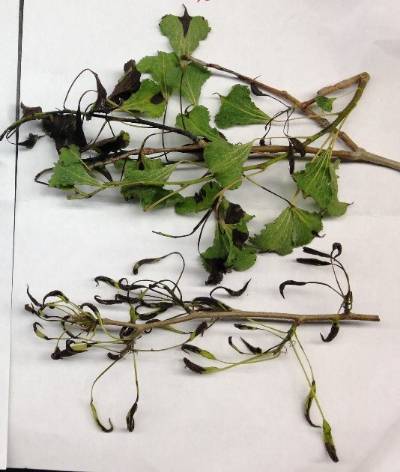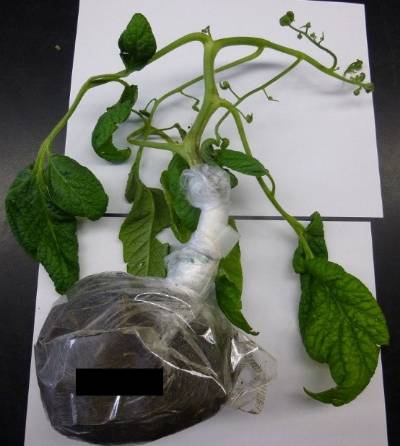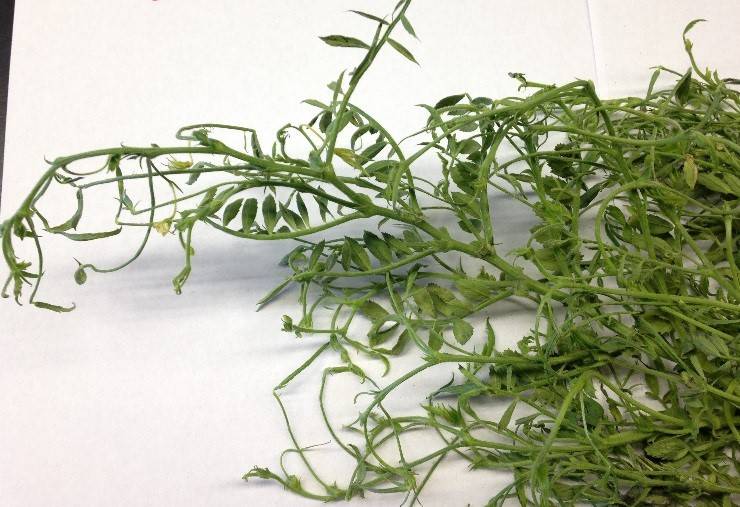Common Sources of Non-Target Herbicide Injury
(by Noelle Orloff, Plant Identification Diagnostician, MSU Schutter Diagnostic Lab)
Download Weed Post on Common Sources of Non-Target Hebicide Injury as PDF (includes word puzzle)

Fig 1. Aspen showing symptoms of suspected herbicide drift (Photo: Noelle Orloff)
Introduction
The Schutter Diagnostic Laboratory (SDL) at Montana State University (MSU) is provided through MSU Extension. One of our roles is assisting producers, pest management professionals, and homeowners with diagnosis of herbicide injury of plants. We have diagnosed 55 samples this year where herbicide injury was suspected as the main cause of plant symptoms. Three main sources of injury have been herbicide drift, carryover in garden amendments, and carryover in pulse crops (i.e. peas and lentils).

Fig 2. Tomato showing symptoms consistent with herbicide carryover (Photo: Noelle Orloff)
Herbicide drift
Almost half of the herbicide injury cases submitted to SDL this year have been from suspected drift of plant growth regulator herbicides in ornamental settings. In these cases symptoms include curling, twisting, and distortion that may be most pronounced on the newest growth (Fig. 1). Plant growth regulators are a group of herbicides including many that are commonly used for broadleaf weed control in lawns and along roadsides such as 2,4-D and dicamba. In these cases homeowners had either applied these types of herbicides on their property, or we suspected they drifted from another property as they can simply drift during application, or some formulations can readily volatilize and drift relatively long distances in gaseous form during periods of high temperatures.
Herbicide carryover in garden amendments
Plant growth regulator herbicides also include some that are very persistent in the environment and are used to control broadleaf weeds in rangeland and pasture, including picloram (Tordon) or aminopyralid (Milestone). These herbicides can persist in manure, compost, topsoil, and hay or straw for a number of years, and applying contaminated amendments to gardens or vegetable crops can cause symptoms of leaf distortion, stem cracking, and poor emergence (Fig 2).
Herbicide carryover in pulse crops
This year we have seen an increase in the number of pulse crop (i.e. chickpea, lentil, and dry pea) samples with symptoms of suspected herbicide carryover.

Fig 3. Chickpea showing symptoms of suspected herbicide carryover (Photo: Noelle Orloff)
Often the herbicides in question are in the ALS inhibitor mode of action group, and symptoms include malformation, stunting, and/or yellowing (Fig. 3). After reviewing herbicide records we find that many of these cases are likely attributed to an application of a soil residual herbicide in past small grain rotations. Some of the products we have been seeing as potential issues include those that have planting intervals for pulse crops of greater than 18 months such as flucarbazone (Everest) and sulfosulfuron (Outrider).
What you can do to avoid non-target herbicide injury
Before using an herbicide, read the product label. Make sure you understand restrictions about weather conditions, re-crop intervals, and pre-harvest intervals to avoid the types of non-target injury described in this article.
